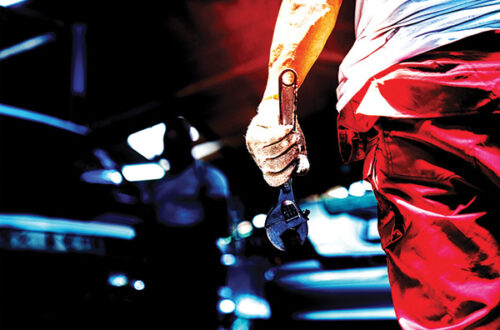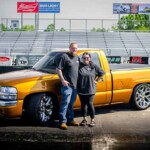
Becoming a Shop of the Future: A WMABA Roundtable Discussion
Published in Hammer & Dolly – Thomas Greco Publishing
From electric vehicles (EVs), ADAS and diagnostics to OEM certification, DRPs and consolidation, the future of the collision repair industry is rife with challenges for shops that want to remain competitive amidst these never-ending changes.
 Retaining employees has become even more important than attracting clients, but simultaneously, no business can be successful without maintaining a superior level of customer service. So, how can an auto body facility navigate the myriad aspects of the business to become a “shop of the future”?
Retaining employees has become even more important than attracting clients, but simultaneously, no business can be successful without maintaining a superior level of customer service. So, how can an auto body facility navigate the myriad aspects of the business to become a “shop of the future”?
WMABA Board members Barry Dorn (Dorn’s Body & Paint; Mechanicsville, VA), Kris Burton (Rosslyn Auto Body; Alexandria, VA) and WMABA President Steve Krieps (Greg Cline Auto Body; Winfield, WV) share their thoughts on some of the industry’s most pressing topics with Hammer & Dolly readers.
Hammer & Dolly: How big is the EV wave going to be? How much of that wave is already here? Is the industry ready for this in terms of getting proper training from the OEMs, I-CAR, etc.? What are the major training resources now and planned for the future? What new safety concerns do they present to technicians? Will shops need to be specialized/certified to properly handle EVs?
Barry Dorn: The EV wave has been here for quite some time and is only growing stronger. Unfortunately, a lot of folks still think they can work on them before being properly trained. There’s a lot that can go wrong with these vehicles from a health and safety aspect; the possibility of electrocution creates dangers that shops really need to take seriously. Lots of training opportunities exist, but I worry that generic EV training gives technicians and insurers the illusion that they know more about these vehicles than they actually do. EVs are each very different…if you look at just one OEM that manufactures four different models, there may be three completely different ways to handle those cars, to approach those systems. Rather than relying on generic training, shops absolutely need to specialize. Our industry is definitely transitioning from a trade to a skilled trade, and our technicians need to be viewed similarly to how the aviation industry looks at their workforce where certain people are trained on specific tasks. The days of doing it all – body work, structural, mechanical, high voltage – are gone. These positions will need to be filled by different people or groups because it’s impossible for a single individual to obtain and retain all the information necessary to effectively repair these vehicles from start to finish.
Kris Burton: It’s not coming; it’s here. For us, the majority of vehicles we repair are EVs, though that’s not true for every shop, and it’s going to continue to grow along with a lot of hybrids. The majority of the industry isn’t ready for the EV revolution because it requires a different mindset. If you make a mistake on an internal combustion engine vehicle, you could damage the car, but a mistake on an EV could lead to the technician injuring or even killing himself on top of damaging the car. We need to take a totally different approach to the repairs, which includes realizing that no technician can be everything to everyone. It’s unfair to expect a technician to know everything about every EV that comes into a shop. It’s going to require specialized knowledge based on different makes and models, so we may have one technician who is trained on Mercedes and BMW, while another is a Tesla tech. We’ve started going down that road at my shop, where specific technicians focus on specific makes and models; they know what tools are required, how to read the repair procedures and how to check the different systems. Each vehicle is different, but when you’re focusing on a specific manufacturer, it becomes easier to interpret their procedures and identify where to find the necessary information. I believe that’s a trend we’re going to see, and shops will need to either learn to play the game or get out of the business.
Steve Krieps: The industry is definitely not ready! Shops in some major markets will be ready to some degree, and some MSOs are taking steps to appear ready, but what about the independents and small dealerships in rural areas that won’t even purchase equipment to work on today’s advanced vehicles? Now they’re expected to install containment chambers in case of thermal runaway. I just don’t see the entire industry adapting properly without a catastrophic event taking place. We used to worry about consumers being hurt if a car was repaired unsafely, but now we have to worry about our technicians and the dangers of repairing an EV if the facility is not properly equipped.
The EV wave is definitely on its way in some markets, but the technology has a long way to go before it’s truly the future. You’ll always have people who want the latest and greatest, whether it’s really “ready” or not, and that’s a problem. We have a handful of EVs in my small rural town, but there’s nowhere around here that is actually equipped to repair them. Still, you’ll see them sitting in shops, and that’s concerning. We cannot even get shops to properly perform scanning and diagnostics; they’re still arguing over pre-measuring and the use of scan tools, but we’re going to turn them loose with little electric bombs? There’s just not enough predictability, and too few facilities have done their due diligence to establish emergency and safety plans to contend with possible problems. I’d like to see specialization or certification requirements, but I cannot see the industry embracing that level of change until there’s no other choice.
HD: How much of a player will OEM-certified shops be in the future? Are they going to replace DRPs? What do shops most need to do to become certified – and maintain that certification down the road?
BD: OEM certification will definitely continue to play a major role in the future as they get more involved in the repair process because they’re seeing how quickly some shops are racing to the floor in terms of poor repairs, largely due to DRP influence. Low-quality repairs reflect badly on the OEM, especially when unsuspecting customers purchase vehicles that have been previously wrecked and a subpar repair causes poor performance which they associate with that vehicle manufacturer. I don’t necessarily think that certification will replace the DRP model, but I believe the DRP model has to change from being solely based on cost reduction, especially with modern vehicles like EVs.
Certification can be pricey, and there’s definitely a cost to stay certified. We need to constantly update tools and equipment, so it can be a tough pill to swallow when we have to replace a piece of equipment after just three or four years instead of decades. Beyond the financial aspect, shops that want to become certified should recognize that there’s a significant investment culturally; certified shops must be dedicated to teaching and learning about these vehicles. That’s paramount and needs to be endorsed within our businesses as a strength.
KB: DRPs became a huge thing in the 1980s and 1990s, but I think we’ve already started to move away from that. While I don’t think the DRP piece will go away completely since that’s the realm where many corporate shops operate, I believe that the way for independent, family-owned shops to differentiate themselves and stand out lies in OEM certification. Simultaneously, I don’t know if it’s for every shop since it requires a different approach to business than many of us are used to. Certifications are hard to get and harder to keep since the shop must be sponsored by a local dealership; that can be tough, especially in major metro areas.You’ve got to develop that relationship, and then you need to invest in tooling and equipment continually. As new makes and models are released, shops have to keep updating their tools, so that continuous investment can be a bit overwhelming. Repairing cars correctly requires a lot of space too, and not only do shops have to invest in training, they need to find the technicians who want to train, not those we have to force to train. All of it takes time, and a shop could easily spend several years putting all the right pieces of the puzzle together.
SK: Tesla gave us our first glimpse of that when they came out with their own insurance, but why reinvent the wheel? OEMs will always do what’s necessary to protect their brand, but when it comes to creating that type of viable program, it seems like they’re all lacking. Some German manufacturers have a better grasp on the certification programs and offer their own training as well as follow ups to ensure the collision facilities are doing things properly, while others simply collect a check and hand over a shiny plaque without ever getting involved. If they did, they could effect a lot of positive change, but there’s also legalities and liability concerns that prevent that. Everyone is worried about protecting themselves and shifting liability, but the buck always seems to stop with us as repair shops.
I think OEM support will definitely be important in the future, but I cannot imagine certification ever completely replacing DRP models. At the same time, I don’t know how DRP models will survive the influx of EVs. It’s really too early to tell how that will all pan out over time. For now, shops that want to obtain and maintain their OEM certifications should keep their checkbooks handy! At the rate things change, expect to spend $10,000 or more to get started and then another $6,000-$10,000 each year to adapt to changes in technology. You also need to consider how that factors into the sustainability of your business, and specialization just may be the answer because making that level of investment on just a couple of manufacturer certifications may be more feasible than trying to maintain dozens of them.
HD: Where is the industry headed when it comes to the scan tools needed to perform diagnostics? Are non-OEM-approved tools going to be enough? Where does the insurance industry come into play?
BD: That last question needs to be addressed first…the insurance industry is here to indemnify their policyholders; they have no role in the repair process. The repair professional determines the repair process. From a scanning and diagnostics side, there’s just no way around it. It’s virtually impossible to be certain you’ve received all the necessary information about a vehicle’s issues and proper recalibration from an aftermarket tool. We need to use OEM-approved scan tools to be sure we’re properly addressing everything that’s wrong with a vehicle after an accident and that it is safely repaired before being returned to the customer.
KB: We don’t use non-OEM tools. We use AirPro, which is an OEM-level pass-through scanner, and anything that they cannot do, we send straight to the dealer. Aftermarket scan tools are not approved or validated by the OEM, and since we view ourselves as an extension of their brand, what they say goes. I can’t imagine using an aftermarket scan tool on these new EVs that don’t have access to their software; those scans are proprietary and have to be performed in-house through the manufacturer.
When it comes to the insurance industry’s role, it all begins with shops educating ourselves on what’s required and necessary to safely repair these vehicles. Are they choosing lower costs over those requirements, or are they going to do the right thing and follow what the OEM requires? Cost shouldn’t be the deciding factor. When negotiating with insurers, we need to make it fact-based by breaking down exactly what the OEM says per line, referencing the repair procedures and explaining what we have to do and why. Documentation is key.
SK: It’s easy for shops to see that manufacturers are using third-party companies to make their software and believe that the company’s aftermarket tool is the same, but a company can make two products with different recipes in the same facility. Right to Repair is going to become a huge factor in how this plays out, and though it may take some time, I suspect there will eventually be some standardization. It would be nice if there was a standard way to connect these vehicles, but that’s a big task, and we aren’t there yet. I’m not sure how the insurance industry will handle all of this; it seems like they cannot agree on anything, but it’s not their liability on the table. Shops need to stay up-to-date on training and get involved with industry events so they can learn from like-minded industry peers and understand better how all these different elements interact in order to make the best possible decisions for their businesses.
HD: How prevalent will consolidation be down the road? Are we going to see a bigger wave in your market in the future?
BD: With all the private equity money being flooded into our industry, consolidation will continue to happen in some markets, but consolidators face one of the same problems that all shops face: there’s a skilled workforce shortage that makes it challenging to be able to maintain the levels of production that we are currently experiencing. So, simply buying shops when the technician defection rate is so huge creates problems for consolidators when they’re unable to attract and maintain the correct workforce. That’s why we’ve focused on growing our own people at Dorn’s Body & Paint for the past 15 years. Rather than hire experienced technicians who want to do things their way, we hire moldable employees who learn to perform repairs according to OEM specifications, and that’s the only way they know how to do it. It’s not always easy, but it’s the right thing to do for the industry’s future survival.
KB: Consolidation is definitely happening in this market, and I think it will continue. We’ve seen a lot of strong consolidators. While I’m not sure there’s much more room for growth in our market, I see it continuing to grow, and I believe DRPs will target the consolidators. That relationship seems to work best for these entities.
SK: Our market is so spread out that we haven’t seen many consolidators yet. Some of the smaller MSOs have made an appearance in West Virginia, mainly in some of the cities like Charleston or Huntington, but we aren’t seeing quite the movement that they’ve experienced in other areas. Still, I don’t think consolidation is going away. As independents become more frustrated with the many obstacles we face in our industry every day, the idea of selling and getting out becomes more appealing. Between a lack of technicians and the need to invest in tools, training and equipment, consolidators will have an easier time gobbling up smaller shops and shrinking markets down to just a couple locations that will have a monopoly in that area.
HD: How will consumer marketing need to change in the future? How will our efforts to educate consumers in the future differ from what we’re doing now?
BD: Most consumers today are very versed in their vehicle and its needs. They understand that their vehicle is different than in the past with the various ADAS conveniences they rely on, and they want to take it to a shop that will look after their investment. Many realize that their vehicle needs were not prioritized in the past, so they’re arming themselves with a lot of information. In all of our communications with the client, from our website to the day they pick up their vehicle, shops need to demonstrate that we are doing things differently, that we’re following OEM requirements and investing in training and equipment to perform proper repairs. If we can’t do that, we’ll never satisfy our clients.
KB: OEMs have and will continue growing their customer service opportunities with innovations like OnStar and the ability to tow vehicles to certified shops. They’re getting to the consumer first, so shops need to change some of our marketing tactics and find ways to reach the consumer before the manufacturer does. That begins with being available at all times by offering after-hours websites, emails and photo estimates, even if we aren’t necessarily staffing anyone 24/7.
SK: Shops should already be educating their consumers, and if they aren’t, they aren’t going to survive. You need to have a process figured out to advertise that includes education and allows you to grab consumers’ attention from the moment they step into your facility by explaining how the process goes. Who are the players, how does the process work, what do we need to do, and why? Nowadays, there’s a lot to a proper repair, and we need to be able to communicate all of that. But consumer education starts with shop education because if you aren’t aware of how all those pieces fit together, it’s easy to get in your own way. Shops need to fight old tendencies to appease bill payers and play on both sides of the fence. You can’t go down the middle of the road; you have to pick which direction you’re going and take that information to the consumer so they know what to expect from your facility. Will you handle challenges that arise on the customer’s behalf, or will you educate them and empower them to deal with their own insurance carrier?
HD: What will shops need to do to attract and retain young employees in the future vs. what worked in the past? What role does shop culture play in employee retention?
BD: As a shop owner or manager, you have to be heavily involved in every employee’s training. Develop a roadmap for growth and recognize when they’re ready to move and advance. It’s no longer about the pay, benefits or even fringe benefits you can offer; it’s more about knowing each team member as an individual and recognizing their unique wants and needs. Today’s technicians don’t want to stay in the same spot for an extended amount of time. We chat a lot with our younger apprentices and explain that this is a career that will take four to six years to get where they need to be, so it’s important that they’re willing to commit to a long-term career with us instead of just looking for a short-term paycheck until something else comes up. We help them understand that this is an investment in their future, and we’re willing to invest our time and energy into training them if they’re willing to make that investment in themselves.
KB: The industry likes to indulge in this narrative that today’s kids aren’t interested in the trade, but I don’t think that’s true. Our local vo-tech high school instructor had 128 kids apply for his class, but he only had 70 open spots; he couldn’t even take on all the kids who were interested in studying auto body! There are fewer vo-tech schools offering these programs now, but the demand is there.
I currently sit on a couple advisory councils for local trade schools and community colleges to participate in helping to shape the future generation. Our shop employed three 17-year-olds this past school year who came to work full-time for the summer. They’re great kids, and they want to work somewhere where they feel safe and supported, where they can grow and feel comfortable. We cannot just throw them on the floor to sink or swim. It’s important to communicate with them and be available to answer their questions. Sometimes they text me after hours because they’re thinking about something that happened that day or they’re worried about tomorrow’s final exam. Nobody has all the answers, but they need someone who is willing to have their back. Two recent graduates want to stay with us full-time because they like it here, and they know that we’re going to help them continue to grow by investing in all the training opportunities available – OEM training, I-CAR, tool companies, etc. There are so many ways for them to learn and grow; it’s truly a great time to be part of this industry.
A lot of shops worry about investing in younger technicians. “What if I train them and they leave?” What if you train them and they stay?! These kids can learn a ton during a one-week hands-on training session, and they’re going to bring all that knowledge back to your facility along with the feeling that you believed in them. That’s worth more than you can realize.
SK: When I entered this industry as a technician, I was blessed to get teamed up with a seasoned tech in a facility that fostered growth, and the goal was to become a flat rate tech. The shop’s goal was to get the work, and the technician’s job was to get the work done. Now, you add in supplements, material shortages and parts shortages which make it much harder for technicians to do their jobs. Many of their daily activities aren’t compensated, and it makes the idea of flat rate pretty unappealing. As a result, they’re cutting corners and missing procedures which isn’t a sustainable system unless we see a huge overhaul in our system.
Because many shops are not collecting what they’re worth, they’re unable to offer a decent benefits package. We’ve put ourselves in the same category as Starbucks or McDonalds where people work temporarily, looking at the job as a stepping stone. We need to be honest with them. This profession can be really rewarding, but we have to show them the real numbers and still find a way to make this work appealing because if we don’t tell them the truth from the beginning, they’re going to leave when they discover that we oversold the image. We need to develop a career path and paint a picture that helps the younger generation see what they can achieve. There’s an amazing opportunity in collision repair, but we have to put ourselves in the shoes of these kids in their late teens and early twenties to help them figure out if this is the career they want to pursue. If it is, we have to help them understand what it takes to get there.




